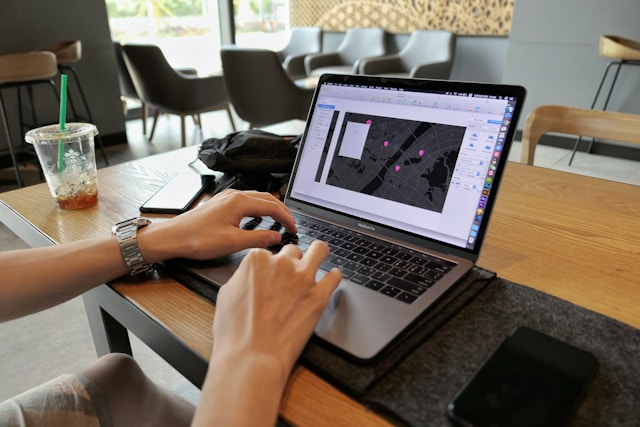
For digital nomads, moving to a new city and quickly adapting to its rhythms is part of daily life. However, the time it takes to settle in will vary depending on personal circumstances, the destination city, and the individual’s ability to adapt. This article explores the different stages of settling in a new city for digital nomads, and the key factors that influence how quickly they adapt.
First arrival in the city: first impression and initial adaptation (1-2 weeks)
When digital nomads set foot in a new city, the first few days are often filled with excitement, exploration, and challenges. At this stage, they not only have to complete some basic arrangements in life, but also quickly understand and adapt to all aspects of the unfamiliar environment. Here are some of the key things a digital nomad goes through when first arriving in a new city, and dive into the details of each.
1. Accommodation arrangements: Choose a comfortable and convenient place
Key considerations:
- geographical location: Location is crucial when choosing a place to stay. Digital nomads often prioritize locations closer to workspaces, coworking locations, or important business districts. In this way, you can integrate into city life more efficiently after work and avoid wasting too much commuting time. An ideal location should also have convenient public transportation, especially in big cities. The distance between subways and bus stops has a direct impact on the convenience of life.
- Network and facilities: For digital nomads, the quality of the network in their accommodation is crucial. High-speed and stable Wi-Fi is the basis for their daily work. In addition, digital nomads often pay attention to the facilities of the house, such as air conditioning, kitchen equipment and washing machines, to ensure that they can successfully carry out long-term residence.
- Short term vs long term rental: When first arriving, many people may choose short-term rentals (such as Airbnb, temporary apartments, etc.) as a transition to give themselves some time to find long-term accommodation in the city. This transition period also helps them better understand the lifestyle and rental market in different areas.
Challenges and Responses:
- When first arriving in a new city, some digital nomads may face difficulty finding housing, especially in high-demand urban areas where rents are high and competition is fierce. At this time, digital nomads can use local rental platforms or social networks to find suitable accommodation.
2. Daily needs: purchasing daily necessities and exploring the surrounding environment
mission critical:
- Supermarkets and markets: In order to ensure the smooth progress of daily life, digital nomads usually visit nearby supermarkets, farmers’ markets, etc. to buy food, daily necessities, medicine and other necessities. In the process, they not only learned about the local product types and prices, but also experienced the shopping culture of the new city. If there is a language barrier, digital nomads may need to adapt to local labels, price tags, or even learn some common vocabulary to shop more efficiently.
- acculturation: Digital nomads need to quickly adjust their eating habits when adapting to a new city. The ingredients and dining methods of some places may be different from their traditional tastes. In this case, you need to gradually integrate into the local culture by trying local food. For example, the street food in Southeast Asia is very different from the fast food in Europe and the United States. Understanding the food safety issues and dining habits of local food is also an important part of the initial adaptation.
- local service: In addition to food shopping, digital nomads also need to solve some other problems in daily life, such as accessing the Internet, purchasing local SIM cards, and understanding surrounding medical facilities. Although these details may seem inconspicuous, they are crucial to improving the quality of life.
Challenges and Responses:
- In more expensive cities, daily expenses may be higher than expected. Especially in some international metropolises, the prices of imported goods in supermarkets and shopping malls may be much higher than local products. Understanding local market price levels and shopping patterns can help digital nomads save money.
3. Familiar with the transportation system: quickly master the city’s travel methods
mission critical:
- public transport: Understand the public transportation system of the new city, especially the lines, timetables and fares of the subway, bus and light rail. Most cities have free subway apps to help passengers check route planning and transfer information. Familiarizing yourself with these tools will not only save you time, but also reduce the risk of getting lost in the city.
- Cycling and walking: For some cities that are suitable for cycling, renting shared bicycles or electric scooters is a good way for digital nomads to quickly adapt to the city. Many cities have complete bicycle lanes and cycling networks. Walking and cycling not only allow digital nomads to quickly become familiar with the city, but also save transportation costs.
- Taxis and shared mobility: Even in cities with convenient transportation, some situations still require the use of taxis or shared travel services (such as Uber, Lyft, etc.). Understanding how to use these services, especially how to make reservations through the APP, and understanding the relevant fee structure can also help digital nomads travel efficiently.
Challenges and Responses:
- For digital nomads who are unfamiliar with the new urban transportation system, they may experience getting lost or missing transportation in the early stages. It is recommended to seek help through map apps, local forums or social media groups to avoid wasting time and resources.
4. Challenges faced: cultural differences and language barriers
Although digital nomads often experience excitement when arriving in a new city, they also face some potential challenges, especially cultural differences and language barriers:
- language problem: Even in cities where English is commonly spoken, digital nomads may encounter language communication barriers, especially when interacting with locals, dining, shopping, or asking for help. The English penetration rate in some cities is low. Learning some basic local language vocabulary and common phrases can help digital nomads better integrate into local life.
- acculturation: In cities with different cultural backgrounds, digital nomads will encounter different social habits, work styles and life rhythms. For example, Western countries may favor direct communication, while Asian countries may focus more on indirect expression and etiquette. Adapting to this cultural difference not only helps them avoid awkwardness in social situations, but also improves the quality of interactions with locals and other digital nomads.
coping strategies:
- language learning: You can quickly master basic communication skills through language learning APPs (such as Duolingo, HelloTalk, etc.), or participate in local language courses to speed up your adaptation.
- cultural understanding: Help yourself integrate into the new environment faster by participating in local cultural activities, social gatherings, or learning about local etiquette and customs through online resources.
Establishment of workspace and social network (2-4 weeks)
In the second phase of being a digital nomad after moving to a new city, a balance between work and social life becomes even more important. At this time, although they have solved some basic life problems, how to find a suitable working environment and establish connections with others is still one of the focuses of their lives. Below are the key tasks and details of this phase.
1. Workspace selection: find an efficient and comfortable working environment
mission critical:
- shared office space: For most digital nomads, coworking spaces are one of the ideal work options. These spaces are usually equipped with basic facilities such as high-speed Wi-Fi, power sockets, and comfortable desks and chairs. However, choosing a shared office space that suits you does not only depend on the completeness of the physical facilities, but more importantly, the working atmosphere of the space. and community atmosphere. Many coworking spaces offer digital nomads social events, professional development sessions, skills workshops, and even teamwork opportunities, which provide valuable opportunities to build a local social and professional network.
- Cafes and remote work locations: In addition to shared office spaces, many digital nomads also choose coffee shops, libraries, or quiet restaurants as their workspace. While these locations may not have the same amenities as professional coworking spaces, they often offer a more flexible, relaxed working atmosphere. During this process, digital nomads need to consider whether the environment in these places is suitable for working for long periods of time, especially network connectivity, noise control, seating comfort, and the layout of the desk space.
- home office: Some digital nomads may choose to work from home, which is a great way for them to save time and enjoy greater autonomy. However, the choice of home office environment needs to ensure a separate and undisturbed work area and ensure efficient working status. Therefore, they may rearrange the space in their home to create a comfortable work area that ensures there are no distractions from family life.
Challenges and Responses:
- When choosing a workspace, digital nomads may encounter problems with a less-than-ideal work environment. For example, some shared office spaces may not provide a quiet work area, or too many social activities may affect work efficiency. At this time, digital nomads can adjust their work location and find an environment that is more suitable for them based on their working style and needs. In addition, the quality of network connections in different places varies greatly, and sometimes it is necessary to personally test the network stability in several places.
2. Socialize and build networks: Integrate into the social circle of the new city
mission critical:
- Attend social events: Building a social network is another important task for digital nomads when settling in a new city. In the early days, they will actively participate in some local social activities, such as digital nomad gatherings, industry conferences, lectures, sports clubs, language exchange activities, etc. These activities not only help digital nomads make new friends, but also help them gain insights into local culture, customs, and lifestyles.
- Online platforms and social media: In addition to offline activities, digital nomads will also expand their social networks through online platforms and social media. For example, using platforms such as Meetup, Facebook, and LinkedIn, they can find local social events, industry communication groups, and even online communities of other digital nomads. Through these channels, digital nomads can quickly integrate into the city’s social circle and discover people with common interests.
- Interact with local residents: Establishing connections with local residents is an important way to understand and adapt to local culture. Digital nomads can gradually build social relationships with locals by participating in community activities, friend recommendations, and even interactions in daily life (such as greeting neighbors, attending local market events, etc.). Especially in places with large language and cultural differences, taking the initiative to communicate with locals can not only improve your language skills, but also deepen your understanding of local society and culture.
Challenges and Responses:
- Digital nomads may encounter language barriers, cultural differences, or time differences when building social networks. For digital nomads who don’t speak the same language, they may experience communication difficulties in the early stages. The solution is to take a language course, use a translation tool, or join a networking event specifically for expats. In addition, for adapting to different cultural backgrounds, digital nomads can gradually understand local social habits and cultural etiquette by observing, learning and participating in more local activities.
3. Work-life balance: discover a rhythm that suits you
mission critical:
- Set work goals: At this stage, digital nomads have usually begun to set specific work goals and gradually adapted to the work rhythm of the new city. Help them stay productive and avoid procrastination by setting clear working hours and to-do lists for themselves. Especially when you don’t have a fixed office, set a clear work plan to avoid being interrupted by other things in your daily life.
- adjust lifestyle: As they adapt to new city life, digital nomads often gradually adjust their daily habits and find a rhythm that suits their lifestyle. Whether it’s a morning workout, a midday social session, or an evening of relaxation, these daily routines can help relieve work stress and promote physical and mental health.
Challenges and Responses:
- For some digital nomads who are just settling in, work-life balance can take a while to find. Some people may feel that they are too busy at first, causing life and work to alternate and cannot be separated. Therefore, it is recommended that digital nomads set reasonable working hours and rest periods for themselves to avoid overworking.
In-depth understanding and integration into local culture (1-3 months)
By the third month of their arrival in a new city, digital nomads have typically transitioned from an initial stage of exploration to a deeper level of adaptation and integration. At this time, they gradually gained a more comprehensive understanding of life in the new city and began to become more integrated from the senses, emotions to culture. Here are a few key details of this phase:
1. Cultural adaptation: in-depth understanding of local lifestyle
mission critical:
- Integration of food culture: Each city has its own unique food culture, and digital nomads may try local specialties in the early stages, but at this stage, they begin to understand local food habits more deeply. For example, street food, traditional restaurants, or specialty markets in some cities have become part of their daily lives. Understanding and adapting to how these foods are prepared, dining habits, and dining etiquette (such as whether there are designated meal times or specific ingredient taboos) are key steps in integrating into the local culture.
- Adaptation to work culture: Differences in work culture in different cities may make digital nomads feel uncomfortable in the early stages. For example, in some countries, the pace of work is slower and breaks are longer, while in other places there is a greater focus on efficiency and quick decision-making. At this point, digital nomads may gradually learn to adjust the way they work, such as paying more attention to time management at work and learning how to communicate effectively within a cultural context, especially when working with locals or other foreign colleagues.
- Social and communication styles: The social style, speech etiquette, and even body language are different in each place. Digital nomads need to come to understand and respect these differences when communicating with local residents. For example, in some cultures, small talk is an important part of social interaction, while in other places, there may be more emphasis on straightforward communication. By actively participating in social activities and communicating with local friends, digital nomads can better integrate into the local social circle and learn how to adjust their behavior according to the cultural background.
Challenges and Responses:
- Language barriers can still be a challenge for digital nomads when adapting to a new culture. Although they may already have basic language skills, they may still have difficulty understanding cultural details, slang expressions, or accents. It is recommended to gradually improve your language skills by taking language courses or communicating more with locals. Additionally, some cultural differences can lead to misunderstandings, and digital nomads need to be patient and learn to learn from each experience.
2. Stability in daily life: Establish fixed living habits
mission critical:
- Establish routines and lifestyle patterns: After two or three months of adjustment, digital nomads have usually found their own routine in a new city. For example, they may start to regularly go to a market to purchase ingredients, or choose to eat at a frequently visited restaurant, cafe, etc., or even start to exercise regularly at a certain gym or activity center. Through this daily activity, digital nomads can not only become familiar with their surroundings, but also better integrate into the local society.
- Personal health management: During this stage, digital nomads often become more focused on their personal health. They may begin to seek local health care services and find a facility for routine physical exams or health screenings. In addition, as they adapt to the local rhythm of life, many digital nomads will also begin to arrange regular exercise, join local gyms, yoga studios, or participate in community sports activities to maintain a good physical and mental condition.
- Transportation and daily convenience: As they become familiar with the city, digital nomads will gradually adapt to the local transportation system and find their most convenient way to travel. For example, they may find that some neighborhoods have heavy traffic while others are relatively quiet; or they may learn how to avoid rush hour traffic and choose more efficient routes.
Challenges and Responses:
- The stability of daily life also means that digital nomads need to face certain emotional and life pressures. When you are away from home for an extended period of time, feelings of loneliness and homesickness may begin to appear at this time. To overcome these challenges, digital nomads can relieve emotional stress through regular video calls, building strong friendships, or participating in community events.
3. Long-term planning and goals: thinking about future directions and choices
mission critical:
- Consider the possibility of long-term settlement: After living in a new city for a few months, digital nomads start to think about whether to make that city their long-term residence. At this point, they may begin to evaluate whether the city meets their career, personal interests, and life needs. For example, some cities may offer better career opportunities, cultural atmosphere, or a low cost of living, while other places may be attracted to long-term residence because of their unique lifestyle.
- Apply for visa and residence certificate: For those digital nomads who plan to live for a long time, applying for a local residence permit or work visa has become an important task. While formalities may not be necessary in the short term, over time many countries’ laws will require digital nomads to register and obtain legal residency status. Understanding local immigration laws and visa policies to ensure that you do not have any legal problems is the key to this stage.
- Tax planning and financial management: Digital nomads also need to consider tax issues over time. Some countries impose taxes on foreigners who have resided for a certain number of days. Digital nomads need to understand their tax responsibilities in their new city and develop reasonable tax planning. In addition, they also need to consider how to manage cross-border financial issues of income and expenses in multiple countries to ensure that their income does not encounter unnecessary trouble due to tax issues.
Challenges and Responses:
- Digital nomads may face uncertainty and anxiety during the long-term planning process. Especially when deciding whether to settle, they may be filled with questions about their future. At this time, digital nomads can help themselves make more informed decisions by communicating with foreigners and local residents who have settled for a long time to understand their experiences and suggestions. In addition, adequate financial planning and legal preparation can also pave the way for long-term residence in the future.
Fully adapted and stable (3-6 months)
Entering the fourth month of living in a new city, digital nomads typically enter a more stable phase. At this time, they have roughly adapted to the local environment and lifestyle, and the adaptation process is almost complete, which is reflected in the deep integration of the following aspects:
1. Adaptation to the rhythm of life: work-life balance
mission critical:
- Seamless connection between work and life: At this point, digital nomads are typically already able to effectively manage the balance between work and personal life. After months of adjustments, they have found a working pattern that suits them, such as deciding when to work, when to take breaks, and how to arrange social and recreational time. At this stage, digital nomads’ schedules become more orderly, and they can work efficiently without neglecting their pursuit of quality of life.
- daily work: Most digital nomads have established a fixed work schedule at this stage, and they choose the work environment that best suits their work needs: some choose to enjoy the social atmosphere and amenities in a shared office space, others Maybe choose a quiet coffee shop or work from home. At this stage, a stable network connection, a comfortable office environment, and reasonable time arrangements can make work and life more smoothly integrated.
- living arrangements: In addition to work, digital nomads also learn how to handle daily chores such as shopping, cooking, cleaning, fitness, etc. These activities gradually become a part of their lives, no longer seem so trivial or burdensome, and gradually become a natural part of daily life.
Challenges and Responses:
- When it comes to balancing work and life, stress can arise. To avoid overwork, digital nomads need to learn to set clear limits on working hours and take regular breaks or recreational activities to maintain physical and mental health. Regularly arranging leisure time, traveling or joining local interest groups can effectively relieve anxiety caused by overwork.
2. Long-term development: expansion of professional and social networks
mission critical:
- Exploration and collaboration of career opportunities: After three to six months of adapting, digital nomads typically start looking for more career opportunities in their new city. As their understanding of the local market deepens, they may develop more collaborations or freelance projects through social networks, participation in industry events, or direct connections with local businesses. At this time, the expansion of professional networks is no longer to adapt to life, but to further develop one’s career and business.
- Entrepreneurship and personal projects: For some digital nomads with long-term career plans, this stage may be the time when they start planning or launching their own entrepreneurial projects. Through the accumulation in the first few months, they will use local resources, industry opportunities or the local entrepreneurial ecosystem to start working on larger-scale projects. Digital nomads at this stage usually no longer rely solely on remote work, but have begun to create more proactive career opportunities.
- Build long-term connections: Digital nomads will not only connect with their peers at this stage, but also develop deeper relationships with local professionals. By participating in regular industry gatherings, social activities and interest groups, digital nomads can better integrate into the local professional circle, understand industry development trends, and obtain more valuable job opportunities or business cooperation resources.
Challenges and Responses:
- Due to language barriers or cultural differences, digital nomads may encounter difficulties in expanding their careers and social networks. At this stage, they may need to be more proactive in interacting with local professionals and work hard to learn how to adapt to different etiquette and communication styles in social situations. By taking language courses or hiring local tutors, they can adapt to local communication methods more quickly.
3. Key factors affecting settlement speed
Personal experience and adaptability:
- Experienced digital nomad: Experienced digital nomads are usually able to adapt to life in a new city more quickly because they are used to frequent moves and have strong adaptability. They can reduce adaptation challenges by quickly learning about the new city’s public transportation, work spaces, social networks, and more.
- Digital nomad relocating for the first time: For first-time digital nomads, the adjustment process can be even slower, as they need to learn from scratch how to manage remote work, integrate into new social circles, and live independently.
City culture and language:
- Cultural differences and language challenges: Cultural differences and language barriers are factors that cannot be ignored in the process of adapting to new city life. For example, some countries in Europe may have a more complex language environment, while some cities in Southeast Asia may have multiple languages coexisting. Language barriers may affect the socialization and work efficiency of digital nomads. For these situations, digital nomads can choose to learn some basic local language ahead of time, or utilize translation tools to help with day-to-day communication.
Support network:
- Digital Nomad with Internet Support: If digital nomads have friends, colleagues or fellow travelers in the new city, they can get more help and advice from these people, and the adaptation process is usually faster. They can provide emotional support and provide faster access to networking opportunities or career information.
- Independent digital nomad: If digital nomads do not have a ready-made social circle, they need to invest more energy in establishing new connections and may encounter certain loneliness or social difficulties. In this case, they need to take the initiative to join activities, social groups, or use social platforms to find like-minded people.
Urban infrastructure and services:
- Infrastructure Impact: The infrastructure of certain cities has a significant impact on the adaptation process of digital nomads. For example, high-speed Internet connections, convenient public transportation systems, 24-hour shops, etc. can greatly improve the work efficiency and quality of life of digital nomads, and help them adapt to the new environment faster. The convenience of the city directly affects the life experience of digital nomads. Good infrastructure allows them to work more efficiently and avoids poor infrastructure from affecting their daily life and work rhythm.
in conclusion
For digital nomads, moving and settling into a new city is a multi-stage process that involves everything from initial adaptation and exploration, to establishing a stable work-life balance, to deeper cultural integration. Overall, the adaptation speed of digital nomads is affected by many factors, including personal adaptability, living conditions in the chosen city, and support from the external environment. Typically, when they first arrive in a city, digital nomads need 1 to 2 weeks to solve basic accommodation, transportation, and daily needs, and in the next 2 to 4 weeks, they begin to find a balance between work and social life. After 1 to 3 months, they are usually able to more fully integrate into the local culture and way of life.
The adaptation process of digital nomads is not only a timeline, but also a process of continuous adjustment and optimization. In this process, digital nomads need to flexibly cope with various challenges from the new environment, such as language barriers, cultural differences, work space choices, etc. They also need to actively participate in social activities, establish local interpersonal networks, and adjust the pace of life to enhance their abilities. A sense of belonging. While every digital nomad’s experience and pace is different, these key steps and coping strategies provide them with a framework for a smooth transition. Ultimately, digital nomads will not only be able to find their own rhythm of work and life in a new city, but also thrive in a diverse culture.





